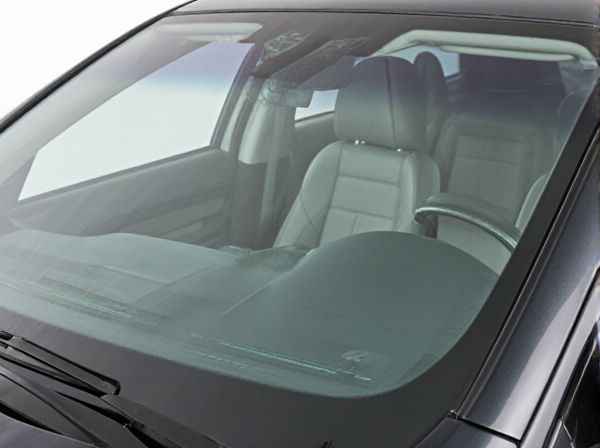
Photo illustration: Polycarbonate vs Glass
Polycarbonate offers superior impact resistance and lightweight properties compared to glass, making it ideal for safety and durability applications. Glass, however, provides better scratch resistance and clarity, often preferred for aesthetic and optical quality in windows and displays. Your choice depends on whether strength or clarity is the priority for your specific project.
Table of Comparison
| Feature | Polycarbonate Windshield | Glass Windshield |
|---|---|---|
| Material | Durable, impact-resistant polymer | Laminated safety glass |
| Impact Resistance | High, resists shattering | Moderate, can crack or shatter |
| Weight | Lightweight, reduces vehicle weight | Heavier, adds to vehicle mass |
| Scratch Resistance | Lower, requires protective coating | Higher, naturally scratch-resistant |
| UV Protection | Integrated UV filtering | Varies, often treated with UV coatings |
| Clarity | Excellent optical clarity | Clear, minimal distortion |
| Cost | Higher initial cost | Lower, widely available |
| Repairability | More difficult to repair | Easier to repair or replace |
| Usage in Vehicles | Used in high-impact, specialty applications | Standard in most passenger vehicles |
Introduction to Polycarbonate and Glass
Polycarbonate is a durable, lightweight thermoplastic known for its impact resistance and optical clarity, making it ideal for applications requiring transparency and strength. Glass, a rigid and brittle inorganic material, offers excellent scratch resistance and optical qualities but is prone to shattering under impact. Both materials serve distinct purposes in construction, automotive, and eyewear industries, with polycarbonate favored for safety and flexibility, while glass excels in clarity and hardness.
Material Composition and Properties
Polycarbonate is a lightweight, amorphous thermoplastic polymer composed of bisphenol A (BPA) units, known for its high impact resistance and optical clarity. Glass is an inorganic, brittle material primarily made of silicon dioxide (SiO2) with high hardness, excellent scratch resistance, and superior thermal stability. The distinct molecular structures influence polycarbonate's flexibility and shatterproof qualities, while glass excels in durability, UV resistance, and chemical inertness.
Strength and Durability Comparison
Polycarbonate exhibits significantly higher impact resistance than glass, with a strength approximately 200 times greater, making it ideal for applications requiring superior durability and shatter resistance. Glass, while more scratch-resistant and maintaining optical clarity over time, is inherently brittle and prone to cracking or breaking under high stress. Polycarbonate's lightweight nature combined with its resistance to extreme temperatures and UV radiation further enhances its lifespan in demanding environments compared to traditional glass.
Weight and Handling Differences
Polycarbonate is significantly lighter than glass, typically weighing about half as much, which enhances portability and ease of installation in applications like eyewear and automotive windows. Its impact resistance and flexibility allow for safer handling and reduced risk of breakage compared to the brittleness of glass. These weight and handling differences make polycarbonate a preferred choice in environments where durability and less strain are critical factors.
Transparency and Optical Clarity
Polycarbonate offers high transparency with up to 90% light transmission, making it nearly as clear as glass, which transmits around 92% of visible light. Unlike glass, polycarbonate maintains optical clarity without the risk of shattering, providing better impact resistance while resisting yellowing over time due to UV coatings. Glass delivers superior scratch resistance and color stability but is heavier and more fragile, making polycarbonate the preferred choice for lightweight, durable applications requiring clear visibility.
Safety and Impact Resistance
Polycarbonate offers significantly higher impact resistance than glass, making it less prone to shattering and ideal for safety applications such as protective eyewear, vehicle windows, and security barriers. Its ability to absorb and disperse force reduces injury risks during collisions or breakage, whereas glass is more brittle and prone to dangerous sharp fragments. Polycarbonate's lightweight and durable nature enhances safety without compromising transparency, outperforming standard glass in impact resilience.
Thermal and UV Resistance
Polycarbonate exhibits superior impact resistance and excellent UV protection compared to glass, making it ideal for outdoor applications requiring durability and sunlight exposure. Glass offers better thermal insulation and higher tolerance to extreme temperatures, maintaining clarity and structural integrity under heat. Both materials provide UV resistance, but polycarbonate's built-in UV stabilizers prevent yellowing and degradation, whereas glass typically requires special coatings to achieve similar protection.
Cost and Economic Considerations
Polycarbonate is significantly more cost-effective than glass, with prices often 50-70% lower, making it an attractive option for large-scale projects and budget-conscious applications. Its lightweight nature reduces structural support and transportation costs, further enhancing economic feasibility over glass. Long-term savings are achieved due to polycarbonate's impact resistance and durability, which minimize replacement and maintenance expenses compared to the more fragile and expensive-to-repair glass.
Environmental Impact and Sustainability
Polycarbonate offers significant environmental advantages over glass due to its lightweight nature, which reduces transportation emissions, and its high impact resistance that extends product lifespan, minimizing waste. Manufacturing polycarbonate generally consumes less energy compared to glass production, which requires melting at very high temperatures. However, polycarbonate is derived from petrochemicals and poses recycling challenges, whereas glass is fully recyclable and made from abundant natural materials, highlighting trade-offs in sustainability profiles between the two materials.
Common Applications and Use Cases
Polycarbonate is widely used in impact-resistant applications such as safety glasses, automotive headlamps, and protective barriers due to its high durability and lightweight properties. Glass remains the preferred material for architectural windows, smartphone screens, and optical lenses because of its scratch resistance and clarity. Both materials serve distinct roles in industries like construction, electronics, and eyewear, with polycarbonate favored for strength and flexibility, while glass is chosen for rigidity and transparency.
 caratoz.com
caratoz.com